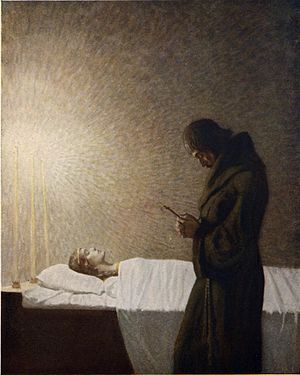Lancelot
| Lancelot | |
|---|---|
| Matter of Britaincharacter | |
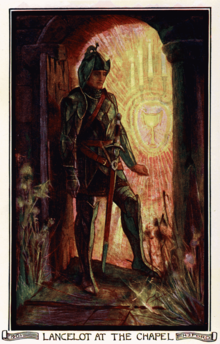 | |
| First appearance | Erec and Enide |
| Created by | PossiblyChrétien de Troyes |
| Based on | Uncertain origins |
| In-universe information | |
| Alias | White Knight,Black Knight,Red Knight, Wicked Knight |
| Title | Prince, Sir |
| Occupation | Knight-errant,Knight of the Round Table |
| Weapon | Secace (Seure),[1] Aroundight[2] |
| Family | Ban,Elaine of Benoic,Lady of the Lake,Hector de Maris |
| Spouse | Elaine of Corbenic |
| Significantother | Guinevere,possiblyGalehaut |
| Children | Galahad |
| Relatives | Lionel,Bors,Bleoberis |
| Religion | Christian |
| Origin | Benoic (in today's northeastern France) |
| Nationality | EitherCeltic BritonorFrench |
Lancelot du Lac(French forLancelot of the Lake), also written asLauncelotand other variants,[a]is a character in some versions ofArthurian legendwhere he is typically depicted asKing Arthur's close companion and one of the greatestKnights of the Round Table.In the French-inspired Arthurianchivalric romancetradition, Lancelot is an orphaned son ofKing Banof the lost kingdom of Benoic, raised in afairyrealm by theLady of the Lake.A hero of many battles, quests and tournaments, and famed as a nearly unrivalledswordsmanandjouster,Lancelot becomes the lord of the castleJoyous Gardand personal champion of Arthur's wife,Queen Guinevere,despite suffering from frequent and sometimes prolonged fits of madness. But when hisadulterousaffair with Guinevere is discovered, it causes a civil war that, once exploited byMordred,brings an end to Arthur's kingdom.
Lancelot's first datable appearance as main character is found inChrétien de Troyes' 12th-century French poemLancelot, the Knight of the Cart,which already centered around hiscourtly lovefor Guinevere. However, another early Lancelot poem,Lanzelet,a German translation of an unknown French book, did not feature such a motif and the connections between the both texts and their possible common source are uncertain. Later, his character and story was expanded upon Chrétien's tale in the other works of Arthurian romance, especially through the vastLancelot-Grailprose cycle that presented the now-familiar version of his legend following its abridged retelling inLe Morte d'Arthur.There, Lancelot's andLady Elaine's sonGalahad,devoid of his father's flaws of character, becomes the perfect knight that succeeds in completing the greatest of all quests, achieving theHoly Grailwhen Lancelot himself fails due to his sins. Both loyal and treasonous, Lancelot has remained a popular character for centuries and is often being variably reimagined by modern authors.
History[edit]

Name and origins[edit]

There have been many theories regarding the origins of Lancelot as anArthurian romancecharacter. In these postulated byFerdinand LotandRoger Sherman Loomis,Lancelot's figure is related to Llenlleog (Llenlleawc), an Irishman in the early Arthurian Welsh taleCulhwch and Olwen(which associates him with the "headland of Gan[i]on" ), and the Welsh hero Llwch Llawwynnauc (most likely a version of theeuhemerisedIrish deityLug[h] Lonbemnech,with "Llwch"meaning" Lake "inWelsh), possibly via a now-forgotten epithet such asLamhcalad,[3]suggesting that they are the same figure; their similarities beyond the name include wielding a sword and fighting for a cauldron inCulhwchandPreiddeu Annwn.Loomis also linked Lancelot to the Welsh mythological heroLleu Llaw Gyffes,whileT. Gwynn Jonesclaimed links between Lancelot andEliwlod(Eliwlad), a nephew of Arthur in the Welsh legend.[4]Proponents of theScythianorigins of Arthurian legend have speculated that an early form might have beenAlanus-à-Lot,that is "Alanof the riverLot",[5]and those looking for clues in classical antiquity see elements of Lancelot in theAncient Greekmythical figures of Askalos and Mopsus (Moxus).[6]
Alfred Anscombe proposed in 1913 that the name "Lancelot" came from Germanic *Wlancloth,with roots in theOld Englishwlenceo(pride) andloða(cloak),[7]in connection withVinoviloth,the name of aGothicchief or tribe mentioned in the 6th-centuryGetica.[8]According to more recent authors, such asNorma Lorre Goodrich,the name, if not just an invention of the 12th-century French poetChrétien de Troyes,may have been derived fromGeoffrey of Monmouth's character Anguselaus, probably a Latinised name of Unguist, the name of a son of the 6th-centuryPictishking Forgus; when translated from Geoffrey'sLatinintoOld French,it would becomeAnselaus.[9]Other 6th-century figures proposed in modern times as candidates for the prototype of Lancelot include the early French saint Fraimbault de Lassay;[10]Maelgwn,king ofGwynedd;[11]and Llaennog (Llaenauc), father ofGwallog,king ofElmet.[12]
Lancelot may have been the hero of a popular folk tale that was originally independent but was ultimately absorbed into the Arthurian tradition. The theft of an infant by a waterfairy,the appearance of the hero at a tournament on three consecutive days in three different disguises, and the rescue of a queen or princess from anOtherworldprison are all features of a well-known and widespread tale, variants of which are found in numerous examples collected byTheodore Hersart de la Villemarquéin hisBarzaz Breiz,byEmmanuel Cosquinin hisContes Lorrains,and byJohn Francis Campbellin hisTales of the West Highlands.As for his name,Lancelotmay be a variant of the French name Lancelin (the word likely meaningjavelinin Old French[13]) as proposed byGaston Parisin 1881, later supported byRachel Bromwich.[14]It is also possibly derived from the Old French wordL'Ancelot,meaning "Servant" (the hypothesis first put forward by de la Villemarqué in 1842); Lancelot's name is actually written this way in several manuscripts.[9]It is furthermore reminiscent of an uncommon Saxon name Wlanc, meaning "The Proud One".[15]
Chrétien and Ulrich[edit]
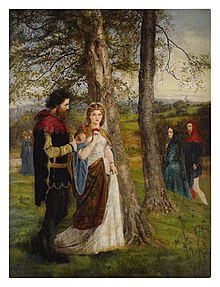
Lancelot's name appears third on a list of knights at King Arthur's court in the earliest known work featuring him as a character: Chrétien de Troyes' Old French poemErec and Enide(1170). The fact that his name followsGawainandErecindicates the presumed importance of the knight at court, even though he did not figure prominently in Chrétien's tale. Lancelot reappears in Chrétien'sCligès,in which he takes a more important role as one of the knights that Cligès must overcome in his quest.[3]It is not until Chrétien'sLancelot, the Knight of the Cart(Le Chevalier de la charrette), however, that he becomes the protagonist and is given the full name Lancelot du Lac (Lancelot of the Lake),[16]which was later picked up by the French authors of theLancelot-Grailand then byThomas Malory.[17]Chrétien treats Lancelot as if his audience were already familiar with the character's background, yet most of the characteristics and exploits that are commonly associated with Lancelot today are first mentioned here. The story centers on his rescue of Queen Guinevere after she has been abducted byMeliagant.In the words ofMatilda Bruckner,"what existed before Chrétien remains uncertain, but there is no doubt that his version became the starting point for all subsequent tales of Lancelot as the knight whose extraordinary prowess is inextricably linked to his love for Arthur's Queen."[18]
Lancelot'spassionfor Arthur's wife Guinevere is entirely absent from another early work,Lanzelet,aMiddle High Germanepic poem byUlrich von Zatzikhovendating from the very end of the 12th century (no earlier than 1194). Ulrich asserts that his poem is a translation of an earlier work from a "French book" he had obtained, assuring the reader that "there is nothing left out or added compared to what the French book tells." He describes his source as written by a certain Arnaud Daniel inProvençal dialectand which must have differed markedly in several points from Chrétien's story. InLanzelet,the abductor of Ginover (Guinevere) is named as King Valerin, whose name, unlike that of Chrétien's Meliagant, does not appear to derive from the WelshMelwas.Furthermore, Ginover's rescuer is not Lanzelet, who instead ends up finding happiness in marriage with the fairy princessIblis.The book's Lancelot is Arthur's nephew, the son of Arthur's sister Queen Clarine. Similar to Chrétien's version, Lanzelet too is raised by a water fairy (here the Queen of theMaidenland), having lost his father King Pant of Genewis to a rebellion.[19]It has been suggested that Lancelot was originally the hero of a story independent of thelove triangleof Arthur-Guinevere-Lancelot and perhaps very similar to Ulrich's version.[20]If this is true, then the motif of adultery might either have been invented by Chrétien for hisChevalier de la Charretteor have been present in the (now lost) source provided to him by his patroness,Marie de Champagne,a lady well known for her keen interest in matters relating tocourtly love.[21]Chrétien himself abandoned the poem for unknown reason, perhaps because of his personal distaste for the subject, which was then finished byGodefroi de LeigniasLanselos del Lac.
Evolution of the legend[edit]
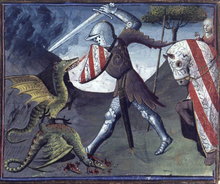
Lancelot's character was further developed during the early 13th century in theOld Frenchprose romanceVulgate Cycle,also known as the Lancelot-Grail. There, he appears prominently in the later parts, known as theLancelot en prose(ProseLancelot), theQueste del Saint Graal(The Quest for the Holy Grail), and theMort Artu(The Death of Arthur). When Chrétien de Troyes wrote at the request of Countess Marie, she was only interested in the romantic relationship between Lancelot and the queen. However, the ProseLancelotgreatly expands the story: he is assigned a family, a descent from lost kingdom, and many further adventures. Gaston Paris argued that the Guinevere-Meleagant episode of the ProseLancelotis an almost literal adaptation of Chrétien's poem, the courtly love theme of which seemed to be forced on the unwilling Chrétien by Marie,[22]though it can be seen as a considerable amplification. The forbidden love affair between Lancelot and Guinevere can be seen as a parallel to that ofTristan and Iseult,with Lancelot ultimately being identified with the tragedy of chance and human failing that is responsible for the downfall of theRound Tablein the later works continuing Chrétien's story.[23]InPerceforest,the different daughters of the ancient knight Lyonnel and thefairy queenBlanchete are actually ancestors of both Lancelot and Guinevere, as well of asTristan.[24]However, much of the ProseLancelotmaterial from the Vulgate Cycle has been soon later removed in the rewriting known as thePost-Vulgate Cycle,where Lancelot is no longer the central protagonist, with the surviving parts being reworked and attached to the other parts of this cycle.
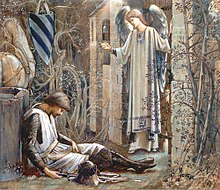
Lancelot is often tied to the religiously Christian themes within the genre of Arthurian romance. His quest for Guinevere inLancelot, the Knight of the Cartis similar to Christ's quest for the human soul.[25]His adventure among the tombs is described in terms that suggest Christ'sharrowing of Hellandresurrection;he effortlessly lifts the lid off the sarcophagus, which bears an inscription foretelling his freeing of the captives.[26]Lancelot would later become one of the chief knights associated with the Quest for theHoly Grail,yet Chrétien did not include him at all in his final romance, the unfinishedPerceval, le Conte du Graal(Perceval, or the Story of the Grail) which introduced the Grail motif into medieval literature.Percevalis the sole seeker of the Grail in Chrétien's treatment; Lancelot's involvement in the Grail quest is first recorded in the prose romancePerlesvaus,written between 1200 and 1210.[27]
German romanceDiu Crônegives Lancelot aspects ofsolar deitytype hero, making his strength peak during high noon, a characteristic usually associated with Gawain.[28]TheMiddle Dutchso-calledLancelot Compilation(c. 1320) contains seven Arthurian romances, including a new Lancelot one, folded into the three parts of the cycle. This new formulation of a Lancelot romance in the Netherlands indicates the character's widespread popularity independent of the Lancelot-Grail cycle.[29]In this story,Lanceloet en het Hert met de Witte Voet( "Lancelot and the Hart with the White Foot" ), he fights seven lions to get the white foot from a hart (deer) which will allow him to marry a princess.[30]Near the end of the 15th century, Malory'sLe Morte d'Arthurfollowed the Lancelot-Grail in presenting Lancelot as the best knight, a departure from the preceding English tradition in which Gawain had been the most prominent.[31]
Cyclical prose tradition[edit]
Birth and childhood[edit]
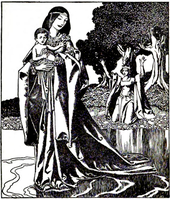
In his backstory, as told in the Vulgate Cycle, Lancelot is born "in the borderland betweenGaulandBrittany"asGalahad(originally writtenGalaadorGalaaz,not to be confused with his own sonof the same name), son of theGallo-RomanrulerKing Banof Bénoïc (English 'Benwick', corresponding to the eastern part ofAnjou). Ban's kingdom has just fallen to his enemy,King Claudas,and the mortally wounded king and his wifeQueen Élaineflee the destruction of their final stronghold of Trebe or Trébes (likely the historic Trèves Castle in today'sChênehutte-Trèves-Cunault), carrying the infant child with them. As Elaine tends to her dying husband, Lancelot is carried off by a fairy enchantress known as theLady of the Lake;the surviving Elaine will later become a nun. In an alternate version as retold in the ItalianLa Tavola Ritonda,Lancelot is born when the late Ban's wife Gostanza delivers him two months early and soon after also dies.
The Lady then raises the child in her magical realm. After three years[32]pass in human world, the child Lancelot grows up and matures much faster than he would naturally do, and it is from this upbringing that he earns the namedu Lac– of the Lake. His double-cousinsLionelandBors the Younger,sons ofKing Borsof Gaul and Elaine's sister Evaine, are first taken by a knight of Claudas and later spirited away to the Lady of the Lake to become Lancelot's junior companions.[33]Lancelot's other notable surviving kinsmen often includeBleoberis de GanisandHector de Marisamong other and usually more distant relatives. Many of them will also join him at the Round Table, as do all of those mentioned above, as well as some of their sons, such asElyan the White,and Lancelot's own son, too. In the proseLancelot,the more or less minorKnights of the Round Tablealso mentioned as related to Lancelot in one way or another are Aban, Acantan the Agile, Banin, Blamor, Brandinor, Crinides the Black, Danubre the Brave, Gadran, Hebes the Famous, Lelas, Ocursus the Black, Pincados, Tanri, and more[34](they are different and fewer in Malory).
An early part of the VulgateLancelotalso describes in a great detail what made him (in a translation byNorris J. Lacy) "the most handsome lad in the land", noting the feminine qualities of his hands and neck and the just right amount of musculature. Diverging on Lancelot's personality, the narration then adds the first mention of his mental instability (which was not explicitly stated in Chrétien's version, although Chrétien's Lancelot is notably relentless on his quest to rescue Guinevere, leaping into danger without thinking and ignoring wounds and pain), in particular proneness to berserk-like combat frenzy:
His eyes were bright and smiling and full of delight as long as he was in a good mood, but when he was angry, they looked just like glowing coals and it seemed that drops of red blood stood out from his cheekbones. He would snort like an angry horse and clench and grind his teeth, and it seemed that the breath coming out of his mouth was all red; then he would shout like a trumpet in battle, and whatever he had his teeth in or was gripping in his hands he would pull to pieces. In short, when he was in a rage, he had no sense or awareness of anything else, and this became apparent on many an occasion.[32]
Lancelot and Arthur[edit]
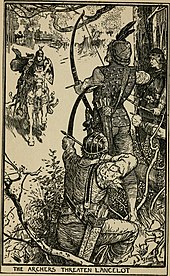
Initially known only as the nameless White Knight (Chevalier Blanc), clad in silver steel on a white horse,[35]the young Lancelot (claiming to be 18 years old, although it is later revealed that he is really only 15[36]) arrives in Arthur's kingdom ofLogreswith the Lady of the Lake to be knighted by the king at her behest. The Lady equips him a powerful magic ring able to dispel any enchantment (as his anonymous fairy foster mother also does in Chrétien's version; later parts of the VulgateLancelotinsteadretconthis as given to him by Guinevere[37]). She also provides him with other enchanted items with various abilities, including a lance, a sword, a tent, and a mirror. She and her damsels continue to aid him throughout the VulgateLancelot.The White Knight later takes the name of his grandfather, King Lancelot, upon discovering his identity.[38]Lancelot eventually is made a member of Arthur's eliteRound Tableafter freeing the king's nephewGawainfrom enemy captivity.
Lancelot and Guinevere[edit]

Almost immediately upon his arrival, Lancelot and the young Queen Guinevere fall in love through a strange magical connection between them, and one of his adventures in the prose cycles involves saving her from abduction by Arthur's enemyMaleagant.The exact timing and sequence of events vary from one source to another, and some details are found only in certain sources. The Maleagant episode actually marked the end of the original, non-cyclic version of the proseLancelot,telling of only his childhood and early youth, before the later much longer versions.[39]
In Malory'sLe Morte d'Arthur,both Lancelot's rescue of the Queen from Meleagant and the physical consummation of their relationship is postponed for years. As described by Malory, after having broken through the iron bars of her prison chamber with his bare hands, "Sir Launcelot wente to bedde with the Quene and toke no force of his hurte honed, but toke his plesaunce and hys lyknge untyll hit was the dawning of the day."[40]This transgression takes place late in Malory's telling, following Lancelot's failure in theGrail Quest.Nevertheless, just as in Malory's "French book" source, his Lancelot too devotes himself to the service of Guinevere early on in his tale. Expanding on the account from thealliterativeMorte Arthure,Malory also has his Lancelot act as one of the chief leaders in Arthur's Roman War, including personally saving the woundedBedivereduring the final battle againstEmperor Lucius.[41]Since much ofLe Mortewas composed unchronologically, the Roman episode actually takes place within Malory's Book II, prior to Book III that relates Lancelot's youth.
Lancelot's initialknight-errantstyle adventures from the Vulgate Cycle did make their way into Malory's compilation range from proving victorious in a tournament fighting on behalf of KingBagdemagus,through slaying the mighty villain Turquine who had been holding several of Arthur's knights prisoner, to overcoming a damsel's betrayal and defending himself unarmed against her husband Phelot. In the adventures exclusive to the VulgateLancelot,his further great deeds include slaying multiple dragons and giants. He also plays a decisive role in the war against theSaxonsinLothian(Scotland), when he again rescues Arthur and Gawain (which he does on several occasions) and forces the Saxon witch-princess Camille to surrender.
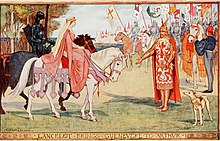
Lancelot dedicates his deeds to his lady Guinevere, acting in her name as her knight. At one point, he goes mad when he is led to believe that Guinevere doubts his love until he is found and healed by the Lady of the Lake.[42]Another instance of Lancelot temporarily losing his mind occurs during his brief imprisonment by Camille, after which he is cured by the Lady of the Lake as well. The motif of his recurring fits of madness (especially "in presence of sexually charged women"[43]) and suicidal tendencies (usually relating to the false or real news of the death of either Gawain orGalehaut) return often throughout the Vulgate and sometimes in other versions as well. He also may harbor a darker, more violent side that is usually suppressed by thechivalric codebut can become easily unleashed during the moments of action.[44]Nevertheless, the VulgateLancelotnotes that "for all the knights in the world he was the one most unwilling to hurt any lady or maiden."[45]
At one point, Lancelot (up to then still going as just the White Knight) conquers and wins for himself a castle in Britain, known asJoyous Gard(a former Dolorous Gard), where he learns his real name and heritage, taking the name of his illustrious ancestor Lancelot as his own. With the help of King Arthur, Lancelot then defeats Claudas (and his allied Romans in the Vulgate) and recovers his father's kingdom. However, he again decides to remain at Camelot, along with his cousins Bors and Lionel and his illegitimate half-brother Hector de Maris (Ector).
Lancelot and Galehaut[edit]
Lancelot, incognito as theBlack Knight[46](on another occasion he disguises himself as theRed Knightas well),[46][47]also plays a decisive role in the war between Arthur and a powerful foreign invader, Prince Galehaut (Galahaut). Galehaut is poised to become the victor and conquer Arthur's kingdom, but he is taken by Lancelot's amazing battlefield performance and offers him a boon in return for the privilege of one night's company in the bivouac. Lancelot accepts and uses his boon to demand that Galehaut surrender peacefully to Arthur. The exact nature of Galehaut's passion for Lancelot is a subject of debate among modern scholars, with some interpreting it as intimate friendship and others as love similar to that between Lancelot and Guinevere.[48]
At first, Lancelot continues to serve Galehaut in his home country of Sorelois, where Guinevere joins him, after Lancelot saves her from the bewitched Arthur during the "false Guinevere"episode.[49]After that, Arthur invites Galahaut to join the Round Table. Despite this happy outcome, Galahaut is the one who convinces Guinevere that she may return Lancelot's affection, an action that at least partially results in the fall of Camelot. In theProseTristanand its adaptations, including the account within the post-VulgateQueste,Lancelot himself harbors in his castle the fugitive loversTristanandIseultas they flee from the vengefulKing MarkofCornwall.

Lancelot becomes one of the most famous Knights of the Round Table, even attested as the best knight in the world in Malory's own episode of Sir Urry of Hungary, as well as an object of desire by many ladies, beginning with the gigantic Lady of Malehaut when he is her captive early on in the VulgateLancelot.An evil sorceress namedHellaweswants him for herself so obsessively that, failing in having him either dead or alive in Malory'schapel perilousepisode, she soon herself dies from sorrow. Similarly,Elaine of Astolat(Vulgate'sDemoiselle d'Escalot,in modern times better known as "the Lady of Shalott"), also dies of heartbreak due to herunrequited loveof Lancelot. On his side, Lancelot falls in a mutual but purelyplatonic lovewith an avowed virgin maiden, whom Malory calls Amable (unnamed in the Vulgate).
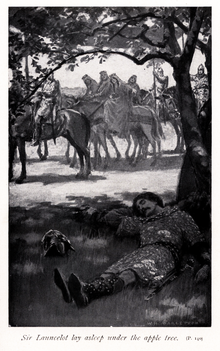
Faithful to Queen Guinevere, he refuses the forceful advances of QueenMorgan le Fay,Arthur's enchantress sister. Morgan constantly attempts to seduce Lancelot, whom she at once lustfully loves and hates with the same great intensity. She even kidnaps him repeatedly, once with her coven of fellow magical queens includingSebile.On one occasion (as told in the proseLancelot), Morgan agrees to temporarily release Lancelot to save Gawain, on the condition that Lancelot will return to her immediately afterwards; she then sets him free under the further condition that he not spend any time with either Guinevere or Galehaut for a year. This condition causes Lancelot to go half mad, and Galehaut to fall sick out of longing for him. Galehaut eventually dies of anguish, after he receives a false rumour of Lancelot's suicide.
Galahad and the Grail[edit]

PrincessElaine of Corbenic,daughter of theFisher King,also falls in love with him but is more successful than the others. With the help of magic, Lady Elaine tricks Lancelot into believing that she is Guinevere, and thus makes him sleep with her by deception.[50]The ensuing pregnancy results in the birth of his sonGalahad,whom Elaine will send off to grow up without a father. Galahad later emerges as theMerlin-prophesied Good Knight, destined for great deeds, who will find the Holy Grail.
But Guinevere learns of their affair, and becomes furious when she finds that Elaine has made Lancelot sleep with her by magic trickery for a second time and in Guinevere's own castle. She blames Lancelot and banishes him from Camelot. Broken by her reaction, Lancelot goes mad again. He flees and vanishes, wandering the wilderness for (either two or five) years. During this time, he is searched for by the remorseful Guinevere and the others. Eventually, he arrives back atCorbenic,where he is recognised by Elaine. Lancelot, shown the Holy Grail through a veil, is cured of his madness, and then chooses to live with her on a remote isle, where he is known incognito as the Wicked Knight (Chevalier Malfait,the form also used by Malory). After ten years pass, Lancelot is finally found by Perceval andEctor,who meanwhile have been sent to look for him by Guinevere (the proseLancelotnarrates the adventures of them and various other knights in the Quest for Lancelot).
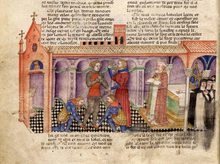
Upon his return to the court of Camelot, Lancelot takes part in the great Grail Quest. The quest is initiated by Lancelot's estranged son, the young teenage Galahad, having prevailed over his father in a duel during his own dramatic arrival at Camelot, among other acts that proved him as the most perfect knight. Following further adventures, during which he experiences defeat and humiliation, Lancelot himself is again allowed only a glimpse of the Grail because he is anadultererand was distracted from faith in God by earthly honours that came through his knightly prowess. Instead, it is his spiritually-pure son who ultimately achieves the Grail. Galahad's also virgin companions, Lancelot's cousin Bors the Younger and Pellinore's son Perceval, then witness hisascensioninto the Heaven. As noted byGeorge Brown,while "Galahad is the typological descendant ofSolomonthroughJoseph of Arimathea,Lancelot is equivalent toDavid,the warrior-sinner. "[51]
Later years and death[edit]
Ultimately, Lancelot's affair with Guinevere is a destructive force, which was glorified and justified in the VulgateLancelotbut becomes condemned by the time of the VulgateQueste.[52]After his failure in the Grail quest, Lancelot tries to live a chaste life, angering Guinevere who sends him away, although they soon reconcile and resume their relationship as it had been before Elaine and Galahad. When Maleagant tries to prove Guinevere's infidelity, he is killed by Lancelot in atrial by combat.Lancelot also saves the Queen from an accusation of murder by poison when he fights as herchampionagainstMador de la Porteupon his timely return in another episode included in Malory's version. In all, Lancelot fights in five such duels throughout the proseLancelot.[53]

However, after the truth about Lancelot and Guinevere is finally revealed to Arthur by Morgan, it leads to the death of three of Gawain's brothers (Agravain,GaherisandGareth) when Lancelot with his family and followers arrive to violently save the condemned queen from being burned at the stake. During her rescue, the rampaging Lancelot and his companions slaughter the men sent by Arthur to guard the execution, including those who went unwilling and unarmed (as did Lancelot's own close friend Gareth, whose head he crushes in a blind rage). In Malory's version, Agravain is killed by Lancelot earlier, during his bloody escape from Camelot, as well as Florent and Lovel, two of Gawain's sons (Arthur's nephews) who accompanied Agravain andMordredin their ambush of Lancelot in Guinevere's chambers along with several other knights from "Scotland". In the VulgateMort Artu,Lancelot's now-vacated former seat at the Round Table is given to an Irish knight named Elians.
The killing of Arthur's loyal knights, including some of the king's own relatives, sets in motion the events leading to the treason by Mordred and the disappearance and apparent death of Arthur. The civil war between Arthur and Lancelot was introduced in the VulgateMort Artu,where it replaced the great Roman War taking place at the end of Arthur's reign in the chronicle tradition. What first occurs is a series of engagements waged against Lancelot's faction by Arthur and the vengeful Gawain; they besiege Lancelot at Joyous Gard for two months and then pursue him with their army into Gaul (France in Malory). The eventual result of this is the betrayal of Arthur byMordred,the king's bastard son (and formerly one of Lancelot's young followers), who falsely announces Arthur's death to seize the throne for himself. Meanwhile, Gawain challenges Lancelot to a duel twice; each time Lancelot delays because of Gawain's enchantment that makes him grow stronger between morning and noon. Lancelot then strikes down Gawain with Galahad's sword but spares Gawain's life (in the Vulgate, despite being urged by Hector to finish him off[54]). However, Gawain's head wound nevertheless proves to be fatal later, when it reopens during the war with Mordred back in Britain. Upon receiving a desperate letter from the dying Gawain offering him forgiveness and asking for his help in the fight against Mordred, Lancelot hurries to return to Britain with his army, only to hear the news of Arthur's death atSalisbury Plain(romance version of theBattle of Camlann).
There are two main variants of Lancelot's demise, both involving him spending his final years removed from society as a hermit monk. In the original from the variants ofMort Artu,after mourning his king, Lancelot abandons society, with exception of his later participation in a victorious war against the young sons of Mordred and their Briton supporters and Saxon allies that provides him with partial atonement for his earlier role in the story.[55]It happens shortly after the death of Guinevere, as Lancelot personally kills one of Mordred's sons after chasing him through a forest in the battle atWinchester,but himself goes abruptly missing. Lancelot dies of illness four years later, accompanied only by Hector, Bleoberis, and the formerarchbishop of Canterbury.It is implied that he wished to be buried beside the king and queen, however, he had made a vow some time before to be buried at Joyous Gard next to Galehaut, so he asks to be buried there to keep his word. In the Post-Vulgate, the burial site and bodies of Lancelot and Galehaut are later destroyed by King Mark when he ravages Arthur's former kingdom.
There is no war with the sons of Mordred in the version included inLe Morte d'Arthur.[26]In it, Guinevere blames all the destruction of the Round Table upon their adulterous relationship, which is the seed of all the dismay that followed, and becomes a nun. She refuses to kiss Lancelot one last time, telling him to return to his lands and that he will never see her face again. Upon hearing this, Lancelot declares that if she will take a life ofpenitence,then so will he.[56]Lancelot retires to ahermitageto seek redemption, with eight of his kin joining him in a monastic life, including Hector. As a monk, he later conductslast ritesover Guinevere's body (who had become an abbess). In a dream, he is warned that she is dying and sets out to visit her, but Guinevere prays that she might die before he arrives, which she does; as she had declared, he never saw her face again in life. After the queen's death, Lancelot and his fellow knights escort her body to be interred beside King Arthur. The distraught Lancelot's health then begins to fail (Le Morte d'Arthurstates that even before this time, he had lost a cubit of height due to hisfastingsand prayers) and he dies six weeks after the death of the queen. His eight companions return to France to take care of the affairs of their lands before, acting on Lancelot's death-bed request, they go on acrusadeto theHoly Landand die there fighting theSaracens( "Turks"in Malory[57]).
Gallery[edit]
-
"How Lancelot fought the six knights of Chastel d'Uter to save theknight of the badly-cut coat."(Tristan en prosec. 1479–1480)
-
Lancelot, dressed in brown, living with his companions in a hermit hut at the end of his life (Tristan en prosec. 1450–1460)
- N. C. Wyeth's illustrations fromThe Boy's King Arthur
-
Facing Turquine: "I am Sir Launcelot du Lake, King Ban's son of Benwick."
-
"Sir Mador's spear broke all to pieces, but his spear held."
-
"[Lancelot] ever ran wild wood from place to place"
-
"Launcelot saw her visage, he wept not greatly, but sighed."
Modern culture[edit]
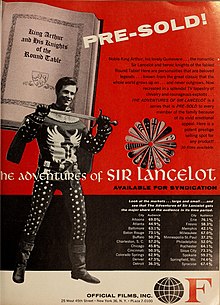
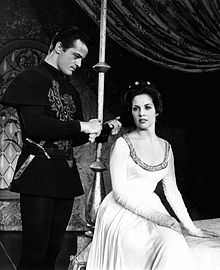
Lancelot appeared as a character in many Arthurian films and television productions, sometimes even as the protagonistic titular character. He has been played byRobert TaylorinKnights of the Round Table(1953),William RussellinThe Adventures of Sir Lancelot(1956–1957),Robert GouletinCamelot(1960),Cornel WildeinSword of Lancelot(1963),Franco NeroinCamelot(1967), Luc Simon inLancelot du Lac(1974),Nicholas ClayinExcalibur(1981),Richard GereinFirst Knight(1995),Jeremy SheffieldinMerlin(1998),Phil CornwellinKing Arthur's Disasters(2005–2006),Santiago CabrerainMerlin(2008–2011),Christopher TavarezinAvalon High(2010),Sinqua WallsinOnce Upon a Time(2012–2015),Dan StevensinNight at the Museum: Secret of the Tomb(2014), and Martin McCreadie inTransformers: The Last Knight(2017), among others.
- T. H. White's novelThe Once and Future King(1958) portrays Lancelot very differently from his usual image in the legend. Here, Lancelot is immensely ugly and introverted, having difficulty dealing with people.
- Lancelot is played byJohn Cleesein the Arthurian comedy filmMonty Python and the Holy Grail(1975). He is portrayed as an awkward knight prone to sudden and uncontrolled outbursts of violence in the section "Sir Lancelot the Brave" that shows his misguided bloody rampage to save a princess who turns out to be a prince and who did not really need to be rescued.[58]He is also a principal character inSpamalot(2005), astage musicaladaptation of the film. Lancelot was played byHank Azariain the original Broadway production. In this version, Lancelot is gay and marries Prince Herbert (portrayed byChristian Borlein the original Broadway production).
- InRoger Zelazny's short story "The Last Defender of Camelot"(1979), the magically immortal Lancelot finally dies helpingMorganasave the world from the madMerlinin the 20th century. He is played byRichard Kileyina 1986 episode ofThe Twilight Zonebased on the story.
- InMarion Zimmer Bradley's novelThe Mists of Avalon(1982), Lancelet is another name of Galahad, and an estranged son of the Lady of the Lake, Viviane. A handsome and great warrior, he is the protagonistMorgaine's cousin and first love interest, himself being bisexual and loving bothGwenhwyfarand Arthur. He is played byMichael Vartanin the novel'sfilm adaptation(2001).
- Lancelot is a major character inBernard Cornwell'sThe Warlord Chroniclestrilogy of novels (1995–1997). This version of Lancelot is presented as a self-serving and cowardly prince of the lost kingdom of Benoic, left by him to be destroyed byFrankishbarbarians. To seize the throne ofDumnonia,Lancelot conspires against Arthur with Guinevere, incites a Christian rebellion, and defects to the invadingSaxons,ending up being hanged by his own half-brother Galahad and by the narratorDerfel(who had lost his daughter to Lancelot's scheming). Lancelot's glowing depictions in legends are explained as merely an influence of the stories invented by the bards hired by his mother.
- Lancelot is a recurring character inThe Squire's Talesseries (1998–2010) byGerald Morris.In some books he is a major character and in others is a secondary character. This version of Lancelot is initially presented as a talented knight, but somewhat pompous and vain. In later books, filled with regret over his affair with Guinevere, he renounces court and is presented as more humble and wise. He leaves court to become a woodcutter, though he is occasionally swept up in quests to help Arthur and other knights.
- The video gameAge of Empires II: The Age of Kings(1999) features Lancelot as apaladin.
- The 2003 novelClothar the FrankbyJack Whyteis told from the perspective of Lancelot. It follows his journeys, starting as a young child until his arrival in Camelot and his meeting withMerlynandArthur Pendragon.
- Lancelot is played byIoan Gruffuddin the non-fantasy filmKing Arthur(2004), in which he is one of Arthur's warriors. He is mortally wounded when he saves the young Guinevere and slays the Saxon chieftain Cynric during theBattle of Badon Hill.
- Thomas Cousseau played Lancelot du Lac in the French comedy TV seriesKaamelott(2005–2009), in which he is portrayed as the only competent Knight of the Round Table and a classically chivalrous hero unlike all the others, however still ill-fated.[59]
- Jason Griffithportrayed him in the video gameSonic and the Black Knight(2009). Lancelot's appearance is based onShadow the Hedgehog.
- Lancelot appears in the light novel and its 2011 anime adaptationFate/Zeroas the Servant "Berserker", played byRyōtarō Okiayu/Kyle Herbert.Lancelot also appears in the mobile gameFate/Grand Orderas a Berserker but also as a Saber class Servant.
- Sophie Cookson's character Roxanne "Roxy" Morton in the filmKingsman: The Secret Service(2014) and itssequeluses the code name Lancelot. It was also used byAaron Taylor-Johnson's character Archie Reid in theprequel.
- Lancelot is the primary antagonist in the first season ofThe Librarians(2014), portrayed by bothMatt FrewerandJerry O'Connell.He gained immortality sometime after the fall of Camelot through magic and has spent centuries seeking to reverse the events that brought about its destruction. As the mysterious Dulaque (a respelling of his namedu Lac), he leads the Serpent Brotherhood, a cult that has long opposed the Library's mission to keep magic out of the hands of humans.
- In the video gameMobile Legends: Bang Bang(2016), Lancelot is a playable character portrayed as Guinevere's brother.
- Giles Kristian's novelLancelot(2018) is an original telling of the Lancelot story.
- The immortal Lancelot Du Lac, voiced byGareth David-Lloyd,is a co-protagonist ofDu Lac & Fey: Dance of Death(2019), an adventure video game set in Victorian London.
- In the illustrated novelCursed(2019) byFrank MillerandTom WheelerLancelot is a violent Christian fanatic known as "The Weeping Monk". In theNetflix adaptation ofCursed(2020), he is played byDaniel Sharman.
- Lancelot is the major character in the animated seriesWizards: Tales of Arcadia(2020), voiced byRupert Penry-Jones.
- Lancelot is featured in the video gameSmiteas a horseback assassin armed with a lance.
- Lancelot is one of the titular knights in the manga seriesFour Knights of the Apocalypse.He is the son of Ban and Elaine.
Notes[edit]
- ^Such as early GermanLanzelet,early FrenchLanselos,early WelshLanslod Lak,ItalianLancillotto,SpanishLanzarote del Lago,and WelshLawnslot y Llyn.
References[edit]
- ^Bane, Theresa (29 May 2020).Encyclopedia of Mythological Objects.McFarland.ISBN9781476639208– via Google Books.
- ^Ellis, George,ed. (1805)."Sir Bevis of Hamptoun".Specimens of early English metrical romances.Vol. 2. London: Longman, Hurst, Rees, & Orme. pp. 165–166.
- ^abBruce,The Arthurian Name Dictionary,p. 305-306.
- ^Johnson, Flint (4 February 2002).The British Sources of the Abduction and Grail Romances.University Press of America.ISBN9780761822189– via Google Books.
- ^Littleton, C.S.; Malcor, L.A. (2000).From Scythia to Camelot: A Radical Reassessment of the Legends of King Arthur, the Knights of the Round Table, and the Holy Grail.Arthurian Characters and Themes. Garland. p. 96.ISBN978-0-8153-3566-5.Retrieved17 August2020.
- ^Anderson, G. (2004).King Arthur in Antiquity.Taylor & Francis. p. 93.ISBN978-1-134-37202-7.Retrieved17 August2020.
- ^Alfred Anscombe (1913), "The Name of Sir Lancelot du Lake",The Celtic Review8(32): 365–366.
- ^Alfred Anscombe (1913), "Sir Lancelot du Lake and Vinovia",The Celtic Review9(33): 77–80.
- ^abJohnson, Flint (14 August 2002).The British Sources of the Abduction and Grail Romances.University Press of America.ISBN9780761822189– via Google Books.
- ^International Arthurian Society (1981).Bulletin bibliographique de la Société internationale arthurienne(in French). p. 1–PA192.Retrieved17 August2020.
- ^Ashley, M. (2012).The Mammoth Book of British Kings and Queens.Mammoth Books. Little, Brown Book Group. p. 149.ISBN978-1-4721-0113-6.Retrieved17 August2020.
- ^Keegan, Simon (17 May 2016).Pennine Dragon.New Haven Publishing, Limited.ISBN9781910705407– via Google Books.
- ^Frédéric Godefroy,Dictionnaire de l’ancienne langue française et de tous ses dialectes du IXe au XVe siècle,édition de F. Vieweg, Paris, 1881–1902, p. 709b.
- ^Goulven Péron, "La légende de Lancelot du Lac en Anjou".Les Cahiers du Baugeois,n°92 (March 2012), pp. 55–63,ISSN0999-6001.
- ^Saklatvala, Beram; Marsh, Henry (27 October 1967).Arthur: Roman Britain's Last Champion.David & Charles.ISBN9780715352014– via Google Books.
- ^William Farina,Chretien de Troyes and the Dawn of Arthurian Romance(2010). Page 13: "Strictly speaking, the name Lancelot du Lac (" Lancelot of the Lake ") first appears in Chrétien's Arthurian debut,Erec and Enide(line 1674), as a member of the Roundtable. "
- ^Elizabeth Archibald, Anthony Stockwell Garfield Edwards,A Companion to Malory(1996). p. 170: "This is the book of my lord Lancelot du Lac in which all his deeds and chivalric conduct are contained and the coming of the Holy Grail and his quest (which was) made and achieved by the good knight, Galahad."
- ^Bruckner, Matilda Tomaryn(2003)."Redefining the Center: Verse and Prose Charrette".A Companion to the Lancelot-Grail Cycle.By Dover, Carol. Boydell & Brewer. pp. 95–106.ISBN9780859917834.JSTOR10.7722/j.ctt9qdj80.15– viaJSTOR.
- ^Schultz, James A. (1991). "Ulrich von Zatzikhoven". In Norris J. Lacy,The New Arthurian Encyclopedia,pp. 481–82. New York: Garland.ISBN0-8240-4377-4.
- ^Cooper, Helen (2006). "Lancelot's Wives".Arthuriana.16(2): 59–62.doi:10.1353/art.2006.0081.JSTOR27870759.S2CID162124722.
- ^Arthurian Literature in the Middle Ages: A Collaborative Historyed. Roger Sherman Loomis, pub. Oxford University Press 1959, special edition for Sandpiper Books Ltd. 2001,ISBN0 19 811588 1pp. 436–39 in Essay 33Hartmann von Aue and his Successorsby Hendricus Spaarnay.
- ^Fulton, Helen (23 November 2011).A Companion to Arthurian Literature.John Wiley & Sons.ISBN9781118234303– via Google Books.
- ^MacBain, Danielle Morgan (1993).The Tristramization of Malory's Lancelot.English Studies. 74: 57–66.
- ^Huot, Sylvia (2 June 2024).Postcolonial Fictions in the Roman de Perceforest: Cultural Identities and Hybridities.Boydell & Brewer.ISBN978-1-84384-104-3.
- ^Raabe, Pamela (1987).Chretien's Lancelot and the Sublimity of Adultery.Toronto Quarterly. 57: 259–70.
- ^abPyle, Howard (1993).King Arthur and the Knights of the Round Table.New York City: Waldman Publishing Corporation. p.238.ISBN978-0-86611-982-5.
- ^Joe, Jimmy."Grail Legends (Perceval's Tradition)".timelessmyths.Retrieved29 May2018.
- ^Loomis, Roger Sherman (30 August 2005).Celtic Myth and Arthurian Romance.Chicago Review Press.ISBN9781613732106.
- ^Brandsma, Frank (1998)."Lancelot".In Gerritsen, Willem P.; van Melle, Anthony G.; Guest, Tanis (trans.) (eds.).A Dictionary of Medieval Heroes.Boydell and Brewer. pp.160–70.ISBN978-0851153810.
- ^"Lanceloet en het hert met de witte voet auteur onbekend, vóór 1291, Brabant".literatuurgeschiedenis.org(in Dutch).Retrieved28 July2021.
- ^Radulescu, R. (2004). "‘Now I take uppon me the adventures to seke of holy thynges’: Lancelot and the Crisis of Arthurian Knighthood." In B. Wheeler (Ed.),Arthurian Studies in Honour of P.J.C. Field(pp. 285-296). Boydell & Brewer.
- ^abLacy, Norris J. (2010).Lancelot-Grail: Lancelot, pt. I.Boydell & Brewer.ISBN9781843842262.
- ^Lacy, Norris J. (Ed.) (1995).Lancelot–Grail: The Old French Arthurian Vulgate and Post-Vulgate in Translation, Volume 3 of 5.New York: Garland.
- ^Lacy, Norris J. (4 February 2010).Lancelot-Grail: The post-Vulgate Quest for the Holy Grail & the post-Vulgate Death of Arthur.Boydell & Brewer Ltd.ISBN9781843842330– via Google Books.
- ^Arthurian Literature XXV.Boydell & Brewer Ltd. 2008.ISBN9781843841715.
- ^Kibler, William W. (22 July 2010).The Lancelot-Grail Cycle: Text and Transformations.University of Texas Press.ISBN9780292786400.
- ^Lacy, Norris J. (2010).Lancelot-Grail: Lancelot, pt. III.Boydell & Brewer.ISBN9781843842354.
- ^"Highlights in the Story".lancelot-project.pitt.edu.Retrieved9 June2019.
- ^Sunderland, Luke (14 April 2010). "Metaphor, metonymy and morality: The Vulgate cycle".Old French Narrative Cycles: Heroism between Ethics and Morality.Boydell & Brewer. pp. 63–100.ISBN9781846158063.
- ^Archibald, Elizabeth; Edwards, Anthony Stockwell Garfield (1997).A Companion to Malory.Boydell & Brewer Ltd. p. 22.ISBN9780859915205.
- ^Lumiansky, R. M. (December 2019).Malory's Originality: A critical study ofle Morte Darthur.JHU Press.ISBN9781421433110.
- ^"La légende du roi Arthur".BnF – expositions.bnf.fr(in French).Retrieved7 October2018.
- ^Plummer, John F. (1996). "Frenzy and females: Subject formation in opposition to the other in the proseLancelot".Arthuriana.6(4): 45–51.doi:10.1353/art.1996.0027.JSTOR27869221.S2CID161934474.
- ^Jesmok, Janet (2007). "The double life of Malory's Lancelot du Lac".Arthuriana.17(4): 81–92.doi:10.1353/art.2007.0042.JSTOR27870873.S2CID161443290.
- ^Lacy, Norris J. (2010).Lancelot-Grail: Lancelot, pt. III.Boydell & Brewer.ISBN9781843842354.
- ^abBruce, ___.The Arthurian Name Dictionary.p. 200.
- ^Lacy, Norris J (2010).Lancelot-Grail 10: Chapter Summaries for the Vulgate and Post-Vulgate Cycles and Index of Proper Names.Boydell & Brewer. p. 40.ISBN9781843842521.
- ^Reeser, Todd W.; Seifert, Lewis Carl (27 October 2008).Entre Hommes: French and francophone masculinities in culture and theory.Associated University Presse.ISBN9780874130249– via Google Books.
- ^"Will the real Guinevere please stand up?".Medievalists.net.17 December 2017.Retrieved8 June2019.
- ^Mike Ashley, Michael Ashley (2005).The Mammoth Book of King Arthur.Running Press. p. 582.ISBN978-0-7867-1566-4.
- ^"Malory's Sangrail".web.stanford.edu.
- ^Dover,A Companion to the Lancelot-Grail Cycle,p. 119.
- ^King, David S. (2016). "Victories foretelling disgrace: Judicial duels in the proseLancelot".South Atlantic Review.81(2): 55–71.JSTORsoutatlarevi.81.2.55.
- ^Baswell, Christopher; Sharpe, William (13 August 2014).The Passing of Arthur: New Essays in Arthurian Tradition.Routledge.ISBN9781317656913.
- ^Dover,A Companion to the Lancelot-Grail Cycle,p. 121-122.
- ^Umland, Samuel J. (1996).The Use of Arthurian Legend in Hollywood Film: From Connecticut Yankees to Fisher Kings.Praeger. p. 91.ISBN978-0-313-29798-4.
- ^Roland, Meg (2006). "Arthur and the Turks".Arthuriana.16(4): 29–42.ISSN1078-6279.JSTOR27870787.
- ^"The Tale of Sir Lancelot".Creative Analytics.16 November 2015.Retrieved29 December2018.
- ^Briand, Cédric (2015).""Kaamelott's" Paradox: Lancelot between Subjugation and Individuation ".Arthuriana.25(1): 22–43.doi:10.1353/art.2015.0013.JSTOR24643427.S2CID166482886.
Bibliography[edit]
- Bruce, Christopher W. (1998).The Arthurian Name Dictionary.Routledge.ISBN978-0-8153-2865-0.
- Dover, Carol (2003).A Companion to the Lancelot-Grail Cycle.D.S. Brewer. p.119.ISBN978-0-85991-783-4.
- Kennedy, E."Introduction".Lancelot of the Lake.Oxford World's Classics. Translated by Corley, Corin. Oxford University Press.
- This article incorporates text from a publication now in thepublic domain:Chisholm, Hugh,ed. (1911). "Lancelot".Encyclopædia Britannica.Vol. 16 (11th ed.). Cambridge University Press. pp. 151–52.
External links[edit]
- Lancelotat The Camelot Project
- An English translation of the ProseLancelotat theInternet Archive
- Lancelot digital expositionat theBibliothèque nationale de France(in French)
- Arthurian characters
- Dragonslayers
- Fictional characters who committed sedition or treason
- Fictional characters with mental disorders
- Fictional clergy
- Fictional French people
- Fictional hermits
- Heroes in mythology and legend
- Holy Grail
- Knights of the Round Table
- Male characters in literature
- Male characters in television
- Mythological princes
- Mythological swordfighters
- People whose existence is disputed


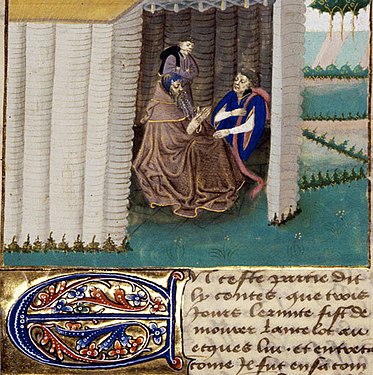
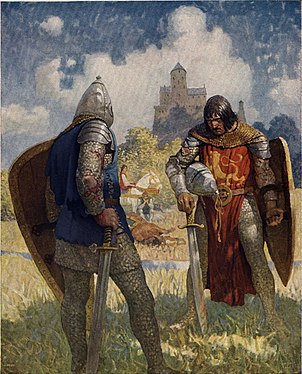

!["[Lancelot] ever ran wild wood from place to place"](https://upload.wikimedia.org/wikipedia/commons/thumb/c/cb/Boys_King_Arthur_-_N._C._Wyeth_-_p52.jpg/300px-Boys_King_Arthur_-_N._C._Wyeth_-_p52.jpg)
